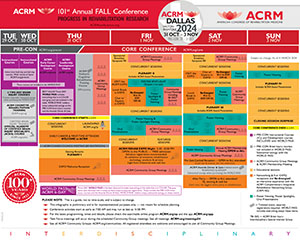Brain Injury
Military and Veterans Affairs
The Relationship Between Cognition and Blast Exposure Symptom Severity in Military Veterans and Servicemembers
Sunday, November 3, 2024
9:30 AM - 10:30 AM
Location: ROOM: Chantilly Foyer REGION: Tower Lobby Level >>> DIRECTIONS: From the ACRM Registration desk, proceed towards the elephants. The Chantilly Foyer is immediately behind the elephants.
.jpg)
Katherine A. Brown, PhD, CCC-SLP
Assistant Professor
Augustana College
Coal Valley, Illinois, United States
Presenting Author(s)
Research Objectives: To investigate the relationship between cognitive performance and deployment-related blast exposure in military servicemembers and veterans. Specifically, the association between measures of fluid and crystalized cognitive performance and severity of symptoms following blast exposure was examined. It was hypothesized that increased severity of blast-related symptoms would be negatively correlated with cognitive performance.
Design: Pearson correlation coefficient was conducted to examine the relationship between cognitive performance measures and blast exposure symptom severity.
Setting: Participants attended one session and completed tasks in an academic research lab.
Participants: Data from United States military veterans or current active duty members, with a minimum of one deployment in support of Operation Iraqi Freedom, Operation Enduring Freedom, or Operation New Dawn campaigns (n = 15) were analyzed.
Interventions: Not applicable.
Main Outcome Measures: Primary study outcome measures were determined a priori. Cognitive outcome measures included fluid and crystalized cognitive composites and total cognitive score, as measured by the NIH Cognitive Toolbox Battery. Primary blast exposure outcome measures included exposure history and severity, determined via self-report of symptoms present at time of exposure.
Results: Results indicated a significant negative correlation between severity of blast exposure symptoms and the Oral Reading Recognition Test (r = -.754, p = .001), the Picture Vocabulary Test (r = -.628, p = .012), and the crystalized cognitive composite score (r = -.748, p = .001). Fluid cognitive composite and discrete measures were not significant.
Conclusions: Increased symptom severity at the time of blast exposure was associated with decreased performance on measures of crystalized cognition. Crystalized cognition, including expressive and receptive language, is widely considered to be less sensitive to traumatic brain injury. One possible explanation for these findings is that blast exposure may represent a distinct sequelae of injury differentially affecting the language domain. Important clinical implications exist; however, more research is needed with a larger sample size to better understand these results.
Author(s) Disclosures: The author has no relevant financial or nonfinancial relationships to disclose
Design: Pearson correlation coefficient was conducted to examine the relationship between cognitive performance measures and blast exposure symptom severity.
Setting: Participants attended one session and completed tasks in an academic research lab.
Participants: Data from United States military veterans or current active duty members, with a minimum of one deployment in support of Operation Iraqi Freedom, Operation Enduring Freedom, or Operation New Dawn campaigns (n = 15) were analyzed.
Interventions: Not applicable.
Main Outcome Measures: Primary study outcome measures were determined a priori. Cognitive outcome measures included fluid and crystalized cognitive composites and total cognitive score, as measured by the NIH Cognitive Toolbox Battery. Primary blast exposure outcome measures included exposure history and severity, determined via self-report of symptoms present at time of exposure.
Results: Results indicated a significant negative correlation between severity of blast exposure symptoms and the Oral Reading Recognition Test (r = -.754, p = .001), the Picture Vocabulary Test (r = -.628, p = .012), and the crystalized cognitive composite score (r = -.748, p = .001). Fluid cognitive composite and discrete measures were not significant.
Conclusions: Increased symptom severity at the time of blast exposure was associated with decreased performance on measures of crystalized cognition. Crystalized cognition, including expressive and receptive language, is widely considered to be less sensitive to traumatic brain injury. One possible explanation for these findings is that blast exposure may represent a distinct sequelae of injury differentially affecting the language domain. Important clinical implications exist; however, more research is needed with a larger sample size to better understand these results.
Author(s) Disclosures: The author has no relevant financial or nonfinancial relationships to disclose
Learning Objectives:
- Describe the cognitive sequelae of blast-induced traumatic brain injury.
- Explain the importance of assessing blast exposure history when completing a comprehensive cognitive evaluation.
- Discuss the clinical implications of a relationship between blast exposure symptom severity and cognitive performance.

.jpg)
.jpg)
.jpg)
